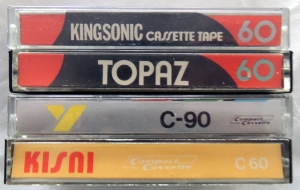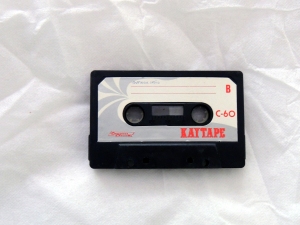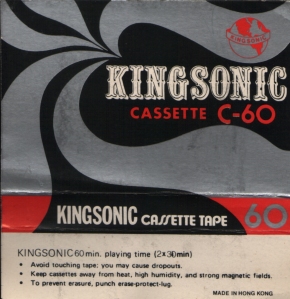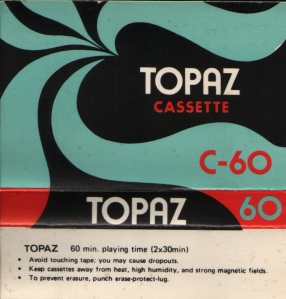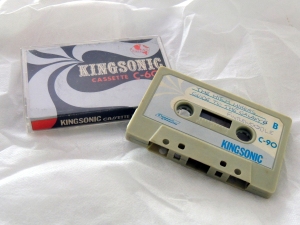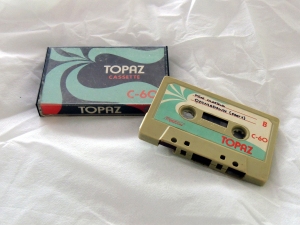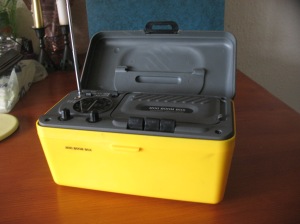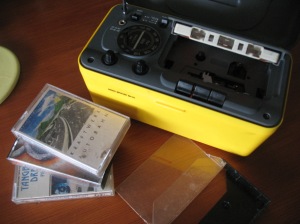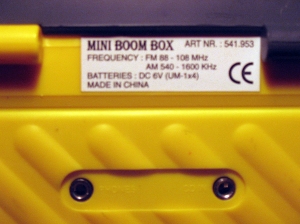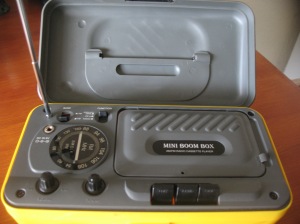Introduction
Sometimes nostalgia can be generated by the unlikeliest of objects. Take cheap audio cassettes for instance. What were once considered a poor man’s substitute for the ‘real thing’, these budget tapes have now had a bit of a revival thanks to the ‘Cassette Underground’, a growing body of people from around the World comprised of Low-Fi music experimentalists and Cassette Tape collectors. Like the veritable scary monster from your average horror movie, these bargain ‘beasts’ have refused to stay dead and are once again wreaking havoc on our tape machines. Retroscoop charts the rise, fall and rise of these unlikely survivors from yesteryear.
If you were an impoverished child of the late seventies / early eighties who liked to record music from the radio or make (illegal) copies of friend’s albums, it is likely that you had to turn to one of the many brands of budget tapes that once flooded the market.
Priced at around 30p – 50p per tape (as opposed to their expensive counterparts such as TDK, priced at around £1.50 each) and sporting names such as Kingsonic, Topaz, Kay, Melsonic – and other ‘brands’ too numerous to mention, they were an absolute life saver for a youth on a tight budget. The incredibly cheap price was purely down to their place of origin – China, where incredibly low manufacturing costs allowed factories to churn them out in their millions for next to nothing.
We were under no illusion that what we got for our 50p was a very ‘low end’ recording experience and, as a consequence of being created out of materials too flimsy for the job at hand, the tape would invariably snap or get sucked into your cassette players mechanism. Due to these (and other) experiences I devised my own ‘3 Universal Laws of Cassette Tapes’, the first rule of which states:
The probability of your cassette failing is directly proportional to how important or irreplaceable the recording on the tape is to you.
Because these cassettes were considered to be extremely harmful to tape machines, they were never stocked in your usual Hi-Fi outlets such as Dixons or Currys etc. Instead, you had to head for the forerunners of today’s pound shops; the discount stores such as Oobidoo, QS Discounts, Superdrug and budget hardware stores that sold everything from thumbtacks to Moth Balls.
As previously stated, these tapes came in a variety of brands, but it didn’t take much observational skill to realise that the majority of them were manufactured by the same company, who did little to disguise the fact. In some instances, different ‘brands’ even used the same artwork and fonts on the cassette inserts. In particular, check out the artwork for Kingsonic and Topaz – identical in every respect save for brand names and font.
Initial research indicates that there was one main firm in Hong Kong that produced all the raw materials, such as the cassette shells, guide wheels and magnetic tape, which was then sold off to one of several cassette assembling firms who put the tapes together and ‘branded’ them for their wholesale customers, printing insert ‘J’Cards and cassette labels, often for several different wholesalers simultaneously. Chances are, that whatever ‘brand’ of cheap tape you chose, you were getting the exact same product, with the same shell mouldings and components – right down to the quality of the oxide layer on the tape itself; the ultimate ‘illusion of choice’ in the audio world.
In its heyday, it has been estimated that Hong Kong cassette manufacturers produced on average13.2 million C-60s and 7.6 million C-90 audio cassettes every month, with most of these destined for the cassette buying markets in Europe.
Cassette tape entered its golden phase in the mid-eighties with the introduction of the Sony Walkman; a highly portable battery-powered cassette player that allowed you to play cassettes anywhere you wanted. But it was the advent of the Compact Disc (CD) and the portable CD player that ushered in the decline of the cassette tape. By the mid-1990s, the demand for cassette tapes had reduced dramatically, leading to the creation of Hi-Fi units without tape players altogether. The final nail in the coffin was brought about in the late 1990s by the introduction of digital recording formats such as MP3, and their associated hardware players which, for the first time, allowed you to take your entire music collection around with you on devices small enough to fit in your pocket. Suddenly Cassettes seemed incredibly bulky and awkward to use by comparison.
However, a mix of nostalgia and a rekindled desire to revisit the ‘excitement’ and ‘rawness’ of audio tape has led to the Cassette revival we see today. Even the mass produced Hong Kong brands are now back in demand with ‘Low-FI’ musicians and experimentalists snapping them up from charity shops and collectors fairs. Vintage blank cassette tapes are now exchanging hands between collectors for ridiculous amounts of money, especially silly considering their original retail prices.
In case you are wondering, the remaining two of the ‘3 Universal Laws of Cassette Tapes’ are as follows:
The amount of recording time you have left near the end of your cassette is always thirty seconds too short for the full length of the song you really wanted to record off the radio.
And
Although most cassettes come with tape boxes to store them in, when it comes to putting them all away, there is always one extra cassette left over when all the tape boxes are full. Always.
